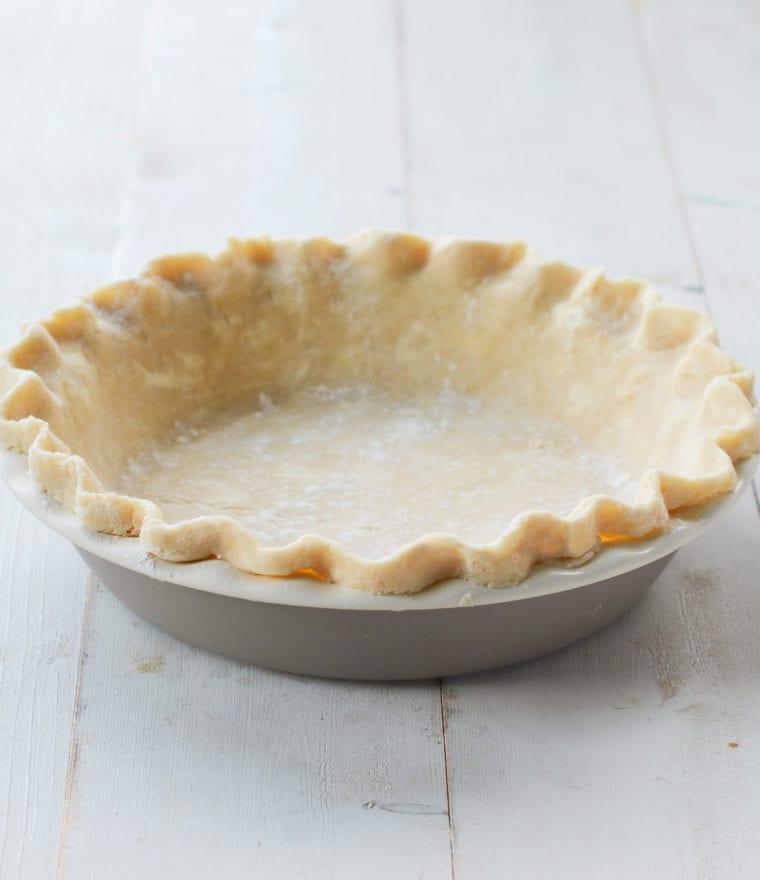
Perfect Pie Crust
Learn how to make the perfect pie crust with this easy recipe. Buttery, tender and flaky—it’s ideal for beginners and seasoned bakers alike!
Ingredients
- 1½ cups all-purpose flour, spooned into measuring cup and leveled with a knife
- ½ teaspoon salt
- ⅛ teaspoon baking powder
- 6 tablespoons very cold unsalted butter, sliced into ¼-inch pieces
- 3 tablespoons very cold vegetable shortening, in 3 pieces
- 4 tablespoons very cold water
Instructions
- Combine the flour, salt and baking powder in the bowl of a food processor fitted with the metal blade. (If you don't have a food processor, see note below.) Process for 5 seconds to blend.
- Add the butter and shortening. Pulse until you have coarse crumbs with lots of pea-sized clumps of butter and shortening within, 15 to 20 one-second pulses.
- Add the water and pulse until the mixture is just evenly moistened and very crumbly, 7 to 10 one-second pulses.
- Dump the crumbly dough out onto a work surface and gather it into a ball.
- Pat the dough into a 5-inch disc and wrap it in plastic wrap. Refrigerate for at least 45 minutes or up to 3 days to rest.
- Take the dough out of the refrigerator and dust your work surface lightly with flour. Place the dough on top and sprinkle a little flour over the dough. Use your hands to quickly knead the dough into a soft and malleable disc (don’t overwork it; you want it just supple enough to roll).
- Roll the dough, turning it frequently and adding more flour as necessary so it doesn’t stick, into a 13-inch circle.
- Fold the dough into quarters without creasing it and transfer it to a 9-inch deep-dish pie pan.
- Gently fit the dough into the pan, easing it inwards rather than stretching it outwards. Don’t worry if it tears, just patch it right back up.
- Trim the edges to ½ inch beyond the lip of the pie pan, if necessary. Turn the edges under to create a rim on the crust (you can use the scraps to patch in any thin areas); then press the rim against the lip of the pan, forming it into an even edge as you go. Using your fingers, crimp the rim. Place the crust in the refrigerator for at least 30 minutes, and then proceed with your pie recipe.
- If your crust requires blind baking: Preheat the oven to 375°F. Remove the crust from the refrigerator and cover with a piece of parchment paper. Fill the crust at least halfway full with dried beans or pie weights. Bake for 15 to 20 minutes, or until the edges are lightly golden and the crust is set. Carefully remove the parchment and weights. If the recipe requires a fully baked crust (such as for a custard pie), return the crust to the oven and bake for an additional 5 to 10 minutes, or until the bottom is golden and cooked through. For recipes requiring further baking, proceed as directed.
- Freezer-Friendly Instructions: The pie crust dough can be frozen for up to 3 months after you’ve formed it into a disc. Wrap it tightly in a layer of plastic wrap and a layer of foil. Before using, thaw the dough in the fridge overnight and then proceed with the recipe.
- Note: If you don’t have a food processor, you can mix the dough by hand. In a large mixing bowl, whisk together the flour, salt, and baking powder until well combined. Add the cold butter and shortening, and use a pastry cutter, two knives, or your fingers to cut the fats into the flour mixture until it resembles coarse crumbs with some pea-sized clumps. Drizzle the cold water over the mixture, one tablespoon at a time, and toss with a fork until the dough just comes together. Avoid overmixing; the dough should still be crumbly but hold together when pinched.
Nutrition Information
Powered by ![]()
- Per serving (10 servings)
- Calories: 163
- Fat: 11 g
- Saturated fat: 5 g
- Carbohydrates: 14 g
- Sugar: 0 g
- Fiber: 1 g
- Protein: 2 g
- Sodium: 72 mg
- Cholesterol: 18 mg